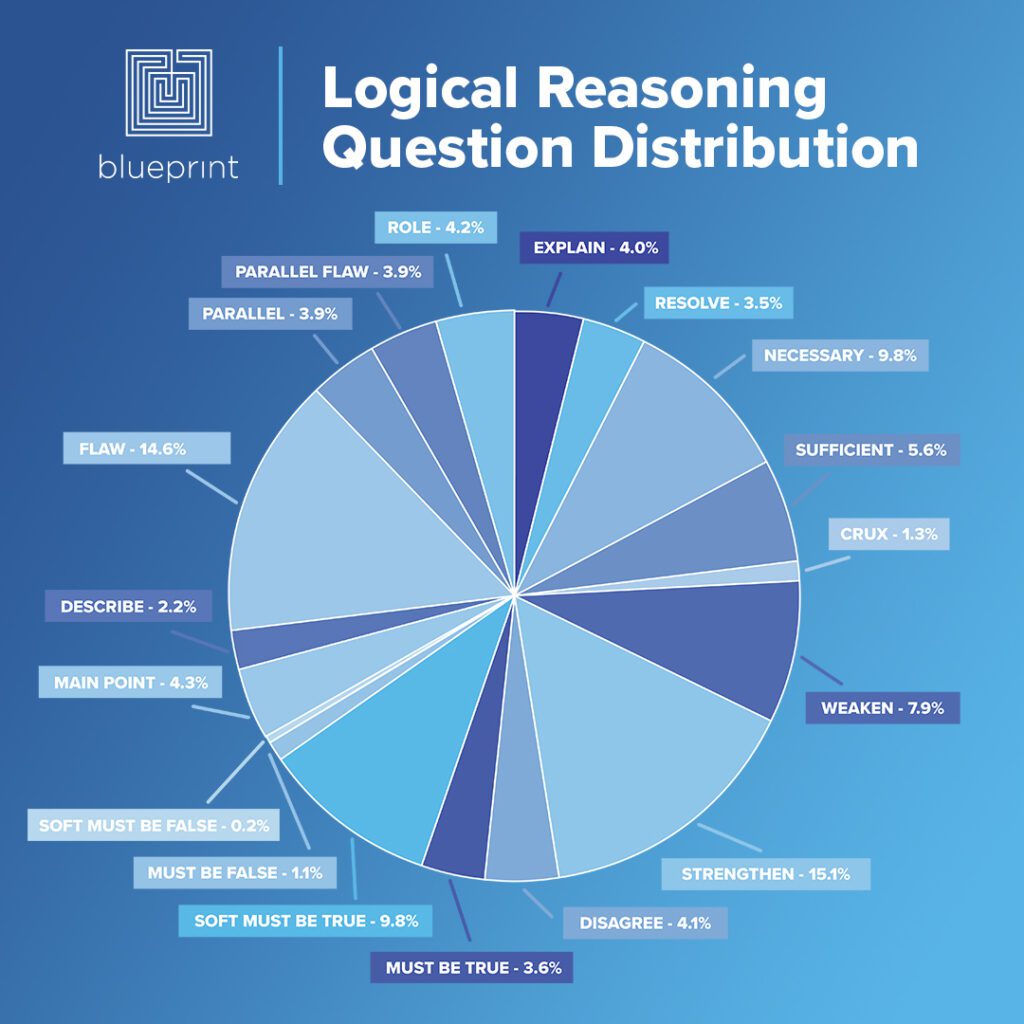Let’s get into a DeLorean, fire up the flux capacitor, and take you back to a different time and place. It’s June 2008. Hulu was just launched, “Low” by Flo Rida was the #1 song, and the year this writer took his LSAT. And wow, did it look different back then! Test booklets. Bubbling. “Pencils down!” But the biggest difference: There were two scored LSAT Logical Reasoning sections!
As a student from that era, I studied Logical Reasoning relentlessly. It was 50% of my LSAT score and a big determining factor for my law school future.
Well, what was old is new again. With logic games going away, the second-scored Logical Reasoning section is making a comeback. Some might think this means the LSAT will get easier, but not so. The Logical Reasoning section requires just as much practice and persistence as Logic Games—and don’t get us started on the Reading Comp section.
For those of us who are less acquainted, we had better get comfortable with the Logical Reasoning question types and skills of the LSAT.
Table of Contents
- What’s Tested on the LSAT Logical Reasoning Section?
- How Many Questions Are in the Logical Reasoning Section?
- Types of Logical Reasoning Questions
- Four-Step Process to Solving Any Logical Reasoning Question
- LSAT Logical Reasoning Question Example
What’s Tested on the LSAT Logical Reasoning Section?
LSAT Logical Reasoning is all about arguments. This is crucial preparation for the path to lawyerdom. The legal world, you may have heard, also cares about arguments.
When we say “arguments,” we don’t mean a contest of who can shout the loudest (although that sometimes happens too). No, we’re talking about a logical battle of wits. Who can convince the court that the law, as applied, favors their client’s view of the case?
Logical Reasoning builds and flexes these very skills. At a basic level, arguments are a series of statements that prove other statements. LSAT Logical Reasoning questions may vary, but they all boil down to these arguments: picking them apart, examining their evidence, and determining what they prove.
Within LSAT Logical Reasoning, these arguments are not strictly about the law (although some of them are). They cover all kinds of subjects, from the existence of unicorns and centaurs to the dinosaurs dying out from drug overdoses. (Yes, really.)
Further Reading
🤔 Is Logical Reasoning Becoming Harder?
How Many Questions Are in the Logical Reasoning Section?
The LSAT Logical Reasoning section has 25 or 26 questions and takes 35 minutes to complete. Starting in August 2024, this means you’ll have two 35-minute sections with 25 or 26 questions each.
Types of Logical Reasoning Questions
My first foray into the LR section was a bit overwhelming. There were so many question types. Ironically, it wasn’t until I started teaching for Blueprint that I found a, well, blueprint that simplified the tasks of these questions.
There are at least 18 types of Logical Reasoning questions that you could encounter on test day. Check out the chart below for a quick breakdown of the question distribution.
Blueprint divides all of Logical Reasoning into three families of questions: Characterization, Implication, and Operation. This is because LSAT Logical Reasoning really only asks us to engage with arguments in three ways.
Characterization Questions
Characterization questions are perhaps the most straightforward. They ask us about something the argument is doing. What’s the main point, or conclusion, of the argument? How can we describe its method of reasoning? How might the argument be flawed? Our job is to dissect the argument, find out, and report back.
Implication Questions
Implication questions ask us to take a more active role in drawing up the argument. Given the evidence in the stimulus, what can we prove? What conclusions can we draw? What is strongly supported, what must be true, and what must be false?
Operation Questions
Operation questions are just as active, but in reverse. The argument has already been written, and we’re asked to change it in some way. How can we give the argument better support? What would weaken it? What assumptions might underlie the argument or help prove it?
Familiarizing yourself with these families will help you approach each question with the right mental frame for reading, thinking, and solving.
The Four-Step Process to Solving Any Logical Reasoning Question
As you dive deeper into your study of this test, you’ll realize just how many question types and specific strategies there are in LSAT Logical Reasoning. For our intro today, we’ll keep it simple.
Every LSAT Logical Reasoning question boils down to a four-step process:
- Identify the Prompt.
- Read the Stimulus.
- Anticipate the right answer.
- Select the correct Answer Choice.
Sign up to get expert tips and exclusive invites to free LSAT classes and law school admissions workshops!
The Prompt is the question being asked. Identifying the prompt means uncovering the family of questions we’re in, the specific question type, and the right strategies to deploy. Basically, if we know what our job is going into the Stimulus, we’ll be that much better prepared as we read.
The Stimulus is the paragraph where the argument lives. It’s where we learn what point the author is trying to prove, what evidence is presented, and where the logic might fall short. It’s where we do most of our reading and much of our thinking.
Anticipation is a critical step we take after reading the stimulus but before diving into the answer choices. It’s where we try to mentally solve the question being asked.
Do we have to anticipate? Short answer: Yes. Long answer: Yeeeeeeessssss!
Going right into the answers without knowing what you’re looking for is a lot like going grocery shopping without a list. You’re just winging it. You risk forgetting why you’re there and getting bait-and-switched into an answer choice that “sounds good in the moment.” (Kind of like that bag of neon-blue Takis on the end cap.)
Finally, the Answer Choices. If our anticipation is on point, we bag the right answer we predicted and get out. If it isn’t quite on point, we look for something close to what we predicted, like a synonym or logical equivalent. In fact, we can even use a process of elimination to eliminate the problem answer choices until we’re left with only one standing using logical force.
LSAT Logical Reasoning Question Example
Let’s apply everything we’ve learned thus far to a real LSAT Logical Reasoning question example. The question below is from the June 2007 LSAT, Section 2, Question 21.
Driver: My friends say I will one day have an accident because I drive my sports car recklessly. But I have done some research, and apparently minivans and larger sedans have very low accident rates compared to sports cars. So trading my sports car in for a minivan would lower my risk of having an accident.
The reasoning in the driver’s argument is most vulnerable to criticism on the grounds that this argument
(A) infers a cause from a mere correlation
(B) relies on a sample that is too narrow
(C) misinterprets evidence that a result is likely as evidence that the result is certain
(D) mistakes a condition sufficient for bringing about a result for a condition necessary for doing so
(E) relies on a source that is probably not well-informed
Step 1: Identify the Prompt
First, let’s start with the Prompt. We’re being asked why the reasoning is “vulnerable to criticism.” This is a classic Characterization family question. To be specific, a flaw question. Basically, we want to characterize, or explain, what the argument is doing wrong.
Step 2: Read the Stimulus
The Stimulus comes second. We know it’s a flawed argument, so we want to have a critical reading frame. Why is this driver full of it?
Let’s take this together one part at a time.
My friends say I will one day have an accident because I drive my sports car recklessly. But…
Okay, let’s stop here. So far there are two notable things (besides the fact that our driver has better friends than they deserve!).
The first thing is the causal language. I will one day have an accident because I drive my sports car recklessly. When I see causal language on the LSAT (especially in flaw questions), I’m thinking there’s a good possibility of a causal fallacy. (More on that in a bit.)
The second thing of note is the disagreement pattern. A lot of arguments on the LSAT take this form. “My friends say A. But the truth is B.” This disagreement pattern is helpful because it shows what the author is seeking to argue (B!).
Now let’s put those two concepts together. “My friends think I’m going to get into a wreck because I’m a reckless driver. But . . . .” In other words, one side believes that the cause of accidents is reckless driving, but the author is going to argue that it’s a different cause.
Let’s keep reading.
But I have done some research, and apparently minivans and larger sedans have very low accident rates compared to sports cars.
Okay, so boring cars like minivans and large sedans are associated with lower accident rates. Got it.
So trading my sports car in for a minivan would lower my risk of having an accident.
Here’s our author’s conclusion: if they trade in their sports car for a Soccer Mom-mobile, this would actually cause their risk of an accident to go lower.
Let’s sum up this driver’s argument: “My friends think I’m going to get in an accident because I drive like an angry Max Verstappen. But the cause isn’t my driving, it’s the car! So if I switch out my coupe for a minivan, I can lower my risk.”
Step 3: Anticipate the Answer
Now that we’ve finished reading, let’s Anticipate. Why might this argument be bogus?
Well, let’s think. If we put Max Verstappen into a minivan, is he suddenly going to stop driving fast? Of course not. Do minivans and boring sedans correlate with lower rates of accidents? Yes. But what type of person typically drives those cars? (Probably not people who drive recklessly!)
In other words, just because minivans correlate with lower accidents doesn’t prove that driving a minivan causes a lower risk of a wreck. (You might be reminded of a maxim from your high school science teacher: “Correlation does not imply causation!”)
Step 4: Select the Correct Answer
With this anticipation in mind, let’s go to the Answer Choices.
(A) infers a cause from a mere correlation
There it is, right up front.
At this point, would I glance at the other answer choices? Yes. I’m not going to let an irrelevant answer choice talk me out of what I’m here for.
(B) relies on a sample that is too narrow
This is an insta-no for me. Why? Because the argument doesn’t tell us anything about the sample in the Driver’s research. “But I have done some research,” they said. This doesn’t equate to a narrow sample. For example, if the Driver said, “I read one article, and now I’m an expert,” then this shoe would fit.
(C) misinterprets evidence that a result is likely as evidence that the result is certain
Here’s a flaw involving something we call logical force. Is it a flaw to do this? Yes. (For example: “There’s an 80% chance of thunderstorms tomorrow, so the Dodgers game will certainly be cancelled.”) However, our argument doesn’t go there. In fact, our argument merely concludes that a result is likely. (“So trading my sports car in for a minivan would lower my risk of having an accident.”) Let’s move on.
(D) mistakes a condition sufficient for bringing about a result for a condition necessary for doing so
What’s this answer choice even saying? My advice: let’s not get bogged down with what the “condition sufficient” or “condition necessary” would be. We anticipated a causation flaw. This is not the flaw we’re looking for.
(For those of you in the know, this is describing a conditional fallacy. For example, “If Max drives, team Red Bull will win” does not imply that Max has to drive in order for Red Bull to win.)
(E) relies on a source that is probably not well-informed
Well, this isn’t true, as far as we know, is it? Similar to answer choice (B), we simply don’t get enough information in the Stimulus to know the reliability of our Driver’s sources. We just know that they “[did] some research.” Let’s leave this one out of it.
Finally, that leaves us with (A) as our correct answer!
Final Thoughts
Logical Reasoning on the LSAT is a beautiful thing. It will definitely make you smarter, more observant, and more critical of the world around you. It will make you a better lawyer someday. Plus, it will make you somewhat annoying in debates and discussions with friends and family! (Just because you’re right doesn’t always make you happy.)
Back when I took the LSAT, 50% of my score came from LR. Starting this August, that number is getting bumped up to 66%. Just imagine, two-thirds of the test that determines so much of your life, coming down to one type of exercise!
The good news is that this stuff is learnable. Having solid methods like we practiced above is critical. However, the real mastery comes from immersing yourself in these methods, practicing and applying them to dozens, hundreds, and even thousands of questions.
With its increased place of importance on the LSAT, Logical Reasoning has now become the signature skill for anyone who’s set their sights on law school. The students who put forward the time and effort to master it will be rewarded.
Ready to practice your Logical Reasonings skills? Create a free Blueprint LSAT account to get access to a free practice LSAT exam with explanations and in-depth performance analytics!
Want more advice from LSAT experts on all the LSAT sections? Come learn from us in a Blueprint LSAT prep course! Whether you have the discipline to study on your own with a Self-Paced Course, want to navigate the LSAT with instructors in a Live Course, or prefer one-on-one attention through tutoring, we have the study method that fits your learning style.





